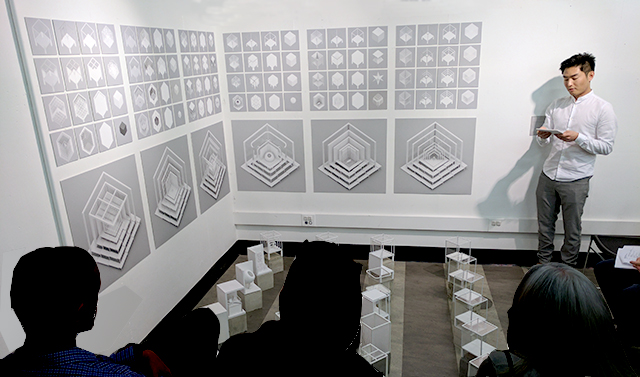
Introduction to Design, Ongoing
Powerpoint of Departure
theory critic: Greg Castillo; representation critic: Kyle Steinfeld; studio critics: vary by semester

In this project, students develop an approach to the rhetoric of architecture and the communication of design ideas.
The history of architecture demonstrates that ours is a discipline that can claim many origins. Just as there a plurality of possible motivations behind an architectural work, there are many points of departure that can animate the process of design. For example, architecture might begin with an idea about the nature of space itself, find expression through a logic of form and modes of representation that facilitate composition. Alternatively, architecture might originate with an understanding of a mode of inhabitation, and proceed through representations that rely on diagram and notation. Some have found a catalyst in the material and processes from which architecture is realized, and have been driven by studies that reveal the tectonic expression of building systems. These are just a few among many possible points of departure on the process of design. Each suggests not only a theoretical stance, but also a set of design methods and representational strategies that facilitate a particular way of approaching an architectural work. While there are many are possible drivers for architectural work, this exercise asks students to consider what motivates them.
We proceed through the preparation of a number of visual / verbal presentations, each of which may include an articulation of a theoretical stance in relation to design, the proposal of an architectural scheme in an early stage of development, and the delivery of a well-developed architectural proposition. Each of these takes the form of a timed visual, verbal and textual presentation delivered "pecha-kucha style" via PowerPoint or similar software.
Short exercises in architectural design, tend to narrowly focus on questions of their own making. As such, we might see these exercises as a sort of artifice - far too constrained to on their own resolve all the questions of a designer faced with the complexities of the real world. The conceptual instruments offered by early exercises in academic design studios are just that: instruments awaiting a performer who is truly motivated by a deeper set of principles, intentions, motives or views. With this in mind, this project reconfigures the conceptual and formal operations to which students have been introduced in their first design studio, and resolves these against the position taken in a manifesto of their own writing in the context of a theory/history course. Through the assembly of a visual and verbal narrative, students aspire to a text that is both a convincing piece of rhetoric - establishing a point of view and persuading an audience to it - as well as a useful guide for action - assembling a particular set of representational strategies and a sequence of investigations that will, over time, bring about the architecture they envision.
Depending upon the relationship between this project and design studio, three types of presentations may be delivered over the course of the semester:
There's more!
Some other projects from this same class have been posted, as well as some interesting student work from this same year.